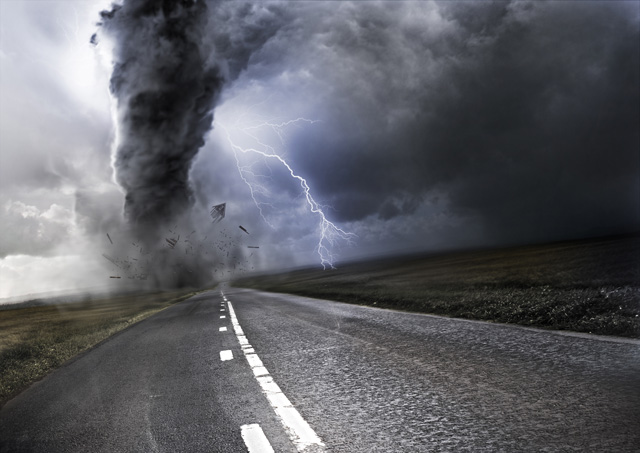[dropcap]It’s[/dropcap] that time of year when leaves and spring pollen are not the only things flying through the air: tornado season. Surviving a tornado, which the Oklahoma Department of Emergency Management calls the “most violent storm on Earth,” can be done with a little knowledge and preparation.
Knowledge
For knowledge, the first thing is to be aware of myths involving tornadoes. Keli Cain, public information officer for ODEM, says the most common myth is the idea a person needs to get out of their house and go somewhere else when tornado sirens sound.
The dilemma of whether a person should leave home or stay and take shelter in a closet or innermost part of their house is one the ODEM encounters every year.
Less than a fifth of Oklahomans have access to a safe, private tornado shelter, according to Tom Bennett, past president of the National Storm Shelter Association.
Cain says the ODEM recommends, in most cases, a person should stay at home during a tornado rather than leave when the sirens are blaring.
The ODEM website offers a handy three-step process in the event you are unable to leave your home: Get in, get down, cover up.
“We always recommend that, number one, you identify your safe place. Then, number two, if you don’t have one, if there’s no place safe, like if you live in an apartment complex on the top floor and there’s no basement shelter, or you live in a mobile home, then we recommend you leave your home,” Cain says. “But do this well in advance of the storm.”
Making tornado safety decisions well in advance means a certain level of preparedness should be a priority for all Oklahomans.
Preparation
The top two things to remember about tornado preparedness, Cain says, is to have multiple layers of warning and a plan.
The layers of warning can include having apps installed on a mobile phone, using a text message warning system, watching the television news and staying in close contact with friends and family.
A battery-operated NOAA Weather Radio, which has a warning alarm function, is a must-have for people who live in Tornado Alley, according to the ODEM website.
“Make plans ahead of time so you won’t have to make difficult decisions when seconds count,” Cain says. For people that have a safe room, Cain says “that’s fantastic” but also make sure people are aware you have it.
If your plan involves having a safe room or storm shelter constructed and installed, Oklahoma has a variety of companies that do such work. Blake Lee, with F5 Storm Shelters in Tulsa, says that both safe rooms and storm shelters are good investments for Oklahomans.
“Above ground safe rooms are a really good option for elderly people or maybe people who are disabled,” Lee says. “Since you don’t have to go down steps in order to access them, they are just much easier for people to get in and out of.”
Also, Lee says, “Statistically, the above ground models are just as safe as being underground as long as the company has their shelters designed to meet FEMA guidelines and has also had their products tested at Texas Tech’s Wind Institute in Lubbock.”
The prices for underground shelters range from $2,799 to $4,300, depending on the size, Lee says.
“Above-ground models can vary just because there are so many different sizing options,” he adds. “Typically, you are looking in the $4,000 to $4,600 range.”
Knowledge and preparation are the keys to tornado safety.
“More people are injured by flying debris or car accidents when they leave their home than they are in the actual tornado, so make those decisions ahead of time and be prepared, have a plan and follow steps when the need arises,” Cain says.
Tornado Facts
- They may strike quickly, with little or no warning.
- They may appear nearly transparent until dust and debris are picked up or a cloud forms in the funnel.
- The average tornado moves southwest to northeast, but tornadoes have been known to move in any direction.
- The average forward speed of a tornado is 30 mph but may vary from stationary to 70 mph.
- Tornadoes can accompany tropical storms and hurricanes as they move onto land.
- Waterspouts are tornadoes that form over water.
- Tornadoes are most frequently reported east of the Rocky Mountains during spring and summer months.
- Peak tornado season in the southern states is March through May.
- Tornadoes are most likely to occur between 3 p.m. and 9 p.m. but can occur at any time.
– Source: www.ready.gov


























